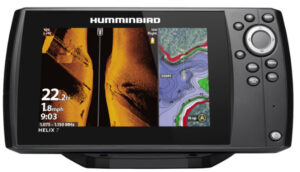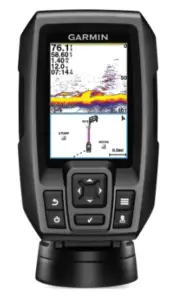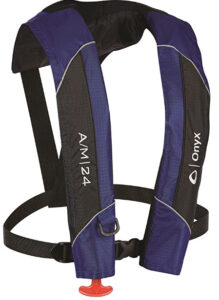What Does A Drift Sock Do? | Why Use A Drift Sock?
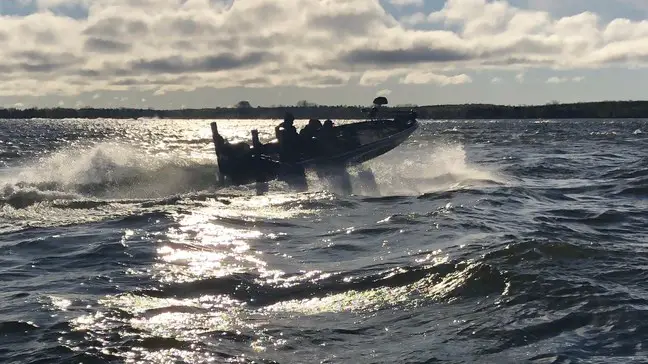
photo cred: WLUK
We’ve ALL been there… you work your butt off the entire week looking forward to going fishing and when you finally get to the water you’re met with windy or even choppy conditions! Sound familiar?
Your solution is – control. But let me tell you, the windier it is the more difficult boat control will be.
Nowadays boats, canoes, kayaks, even paddle boards are becoming bigger and heavier in size.
Translating into a bigger target for the wind to push against and move you off your spot!
If you’re lucky enough you can use a spot-lock trolling motor, but those are known to drain your battery fast, have proven to be unreliable in keeping your position, and even cost $3000 dollars!
This is why you need a drift sock.
No matter what size body of water you’re on, if you have wind or current you need a drift sock.
Key Takeaways
For most anglers using a drift sock can seem pretty exciting yet somewhat intimidating. Here is a quick and easy to follow list to help you get started fast!
- Embrace the idea of deploying a drift sock to silently slow your boat or kayak in current or wind!
- Prepare by having the right size drift sock that matches your vessel… getting a drift sock too small will not slow your boat or kayak down enough.
- Never forget to pull in the drift sock by the collapsing cord… it will help prevent throwing out your back.
- There are various positions to deploy the drift sock on your boat.
- Confidently choose use a drift sock all year long… even if everyone else is tell you not to.
What is a Drift Sock?
Simply speaking, a drift sock (also known as a drift anchor) is like a parachute, or a large funnel-like product but for the water.
More often than not a drift sock will be made up of a nylon cloth material, but the cheaper versions can be made of a cheap tarp-like material. It can also be easily folded up and stored when not in use.
The better drift socks usually come in a kit. The kit usually comes with 1-2 marine-grade ropes, a buoy and the actual drift sock itself.
What does a drift sock do?
A drift sock can be used in a variety of ways.
The most common way drift sock is used is to slow down a boat’s drift. A drift sock can be attached to either of the sides of the boat (port), the front of the boat (stern), or the rear of the boat (aft).
In addition, the drift sock can also be used to hold the boat position when it is anchored.
Who uses a drift sock?
Fishermen are the most common people who use a drift sock for trolling. Anyone who fishes out of a boat, canoe, kayak, stand up paddle board, or any other type of floating vessel should have a drift sock ready to use.
Other recreational boaters also like to have 1-2 drift socks handy, just in case their motor goes out on them the drift sock will help slow their drift. This could be instrumental to allow rescuers to find that boat quickly and easily.
I’ve sat down with other owners of drift socks. They go on to say one of the drift socks best features is to slow their boat drift into a rocky shore just in case they can’t get their motor started.
Drift Sock Anatomy 101 | What Makes A Good Drift Sock Kit?
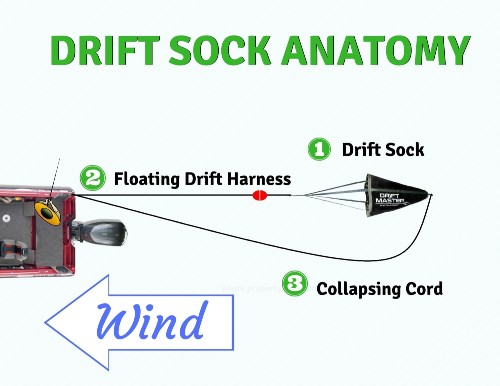
In order to use your drift sock system you should have these three important pieces:
- A harness line.
- A drift sock.
- A collapsing cord.
The Harness Line
The harness line should be a long 100% UV resistant marine grade polypropylene rope. Marine grade cordage rope is known to resist drying out, fraying, and frankly it can last you nearly a lifetime.
Harness lines should be at least an ½-inch thich and should range between 10- and 16-feet in length to give you optimal control.
The premium harness lines come with stainless steel quick release clips on both ends. This will make it so much easier when you attach and remove both the harness from your boat.
You will notice the better harness lines should have a highly visible buoy. The buoys will range in size from 4-8-inches in length.
The harness line with buoy serves four functions:

- It keeps the drift sock towards the top of the water surface, which increases performance and helps to avoid any unwanted snagging on submerged structure.
- Allows the entire system visible at all times.
- In the event your harness and collapsing line comes off your boat, the buoy keeps the entire drift anchor afloat.
- Finally, it also aids you in landing monster fish! Those who are hooked into a giant fish tend to get worried their line will get tangled in the drift sock ropes. Here’s the solution… simply detach the drift sock from your boat! land that monster fish and then come back for the floating drift sock. Super Easy!
WARNING: Do NOT use an ordinary rope to attach your drift sock to your boat. You might be inclined to, but this could have terrible consequences.
Dragging the sock through the water using ordinary rope increases the chances the sock will twist, tangle, hinder the drift sock performance, and wind up frequently removing the harness from the sock and untangle the lines.
The Drift Sock

The drift sock has several parts that give its unique characteristics.
Let’s start from wide-end to the narrow-end:
(1) The Harness Strap – These straps attach to the Bucket and to the harness line. The harness strap needs to be made of a durable nylon material strapping.
(2) The Bucket – Is the opening where the water will get pushed to. Quality of the bucket material can vary. I recommend a drift sock that is made from heavy duty, construction grade rip-stop nylon material.
(3)The Point – The narrow end of the drift sock.
(4) The Collapsing Strap – This is strap where your collapsing cord will tie on to.
(5) Collapsing Cord – Should be a 15- 20 foot Marine-Grade/ UV resistant 1/2-inch cord.
The Collapsing Cord
The collapsing cord is often overlooked as an integral piece to your drift sock kit.
Like the harness line, the collapsing cord should also be made out of UV resistant marine grade polypropylene rope.
The collapsing cord will save your back – literally!
When you are done using your drift sock, you do not pull in the harness line. If you do this you could injury your back since you are pulling against the water that has filled the drift sock.
Pulling on the harness line could also place unneeded stress on the harness straps and could cause tearing over time.
Before deploying your drift sock system simply tie one end of the collapsing strap to your boat and the other end to the drift sock collapsing strap.
The best practice is to pull in your drift anchor after use is pulling in the collapsing cord. The collapsing cord quickly and easily collapses the inflated drift sock.
Getting Started With Your Drift Sock…
Step 1) – Start by choosing a cleat with a hole big enough for the harness line to clip or tie down on to.
It’s easier if you’re using a kayak with an anchor trolley you can rapidly adjust the location of the drift sock.
The easiest and most common location to attach the drift sock harness is the aft of your boat.
Later in this post I’ll go over additional locations where you can attach your drift sock.
Step 2) – Clip the other end of the harness line to the drift sock harness straps.
Step 3) – Tie off one end of the collapsing cord to your boat or the harness line carabiner clip.
Step 4) – Then tie down the other end of the collapsing cord to the collapsing strap located on the narrow end of the drift sock.
Step 5) – Place the sock in the water and allow it to expand slowly/open up and fill with water.
Step 6) – You can let out as much or as little amount of the harness line that you want. Make sure the buoy is closer to the drift sock. Furthermore, I recommend positioning the sock out approximately 6-10 feet at first.
Helpful Tip: If the weather is giving you choppy water conditions, try to let out as much rope as you can for better control.
Allow your Drift Master Drift Sock to slowly drift or slow troll.
When you’re ready to move spots, simply pull in the collapsing cord to “collapse and dump” the water out of the sock.
How do you use drift socks for trolling or drift fishing?
The preferred way to use your drift sock for trolling is to first find the fish or landmark on the map you want to target.
Then continue past the spot heading into the wind.
Drop all lures or bait into the water that you want to use.
Deploy your drift sock and let it slow the boat down. This will allow for your lures to remain in the strike zone longer, giving your more opportunity to catch a fish.
How far out do you have to motor past before starting to drift over the target area?
It depends on a number of factors such as wind or current speed, the size of your boat, and what type of lure you are using.
If the wind speed is really blowing, you want to position your boat farther back. It will take a least a minute or two to deploy the drift sock and for it to inflate and slow down the boat.
In windy conditions, it can really push you over the target spot faster than you think. So you’ll have to time it through trial and error.
Helpful Tip: Whatever distance you think you need to start your drift at, triple it.
Larger vessels also can take longer to slow down. Many anglers like the option of using multiple drift socks to allow them the flexibility to drift at different speeds.
Using different styles of lures also plays a factor of how far past your target you need to go before you start to drift back.
For instance, if you are trolling jig heads with soft plastic grub trailers that lure sinks fast. You can easily drop the lure down to the desired depth, either using a line counter you just count the lure down in your head. Then start your drift over the target area.
However, you need a different approach if you’re trolling crankbaits or jerkbaits. Hard plastic baits that have diving bills will often need extra distance to dive down to get to the desired diving depth.
With this in mind it’s best to give yourself at least 3-times the normal distance.
How To Use A Drift Sock On A Boat Or Kayak
As I alluded to earlier there are multiple ways to use a drift sock for trolling. Here are some of the best ways to use a drift sock for your boat or kayak.
Forward Stroll
One of the easiest setups that we recommend to start is the slow troll (ie; Stroll). This will slow your boat down when moving forward. Remember, the wind has to be at your back.
All you have to do is attach your drift sock system to the stern of your boat.
If you have a trolling motor in the front you can steer the bow left or right.
Sideways Drift
Start by turning your boat perpendicular to the wind.
Using two drift socks is preferred. One will attach near the bow and the other at the stern.
For bow use, the smaller 33-inch drift sock is recommended.
Likewise, for the stern, you can either use a 30-inch drift sock (for a smaller boat) or a larger 50+ inch drift sock for larger/heavier boats.
Helpful Tip: Use your trolling motor to adjust your position the sideways drifting too! It will aid you and push you forward or backward in any direction you need to be at.
As a word of caution, it is not recommended to drift sideways in very windy or heavy choppy conditions. It could possibly rip the cleat off the boat or even capsize your boat!
If you find yourself repositioning the cleats on your boat, the cleat should be located a few inches behind your trolling motor. That way it does not get in the way when you’re raising it or deploying the motor.
The right cleat should be at the equidistance from the bow.
Choppy Conditions = Long Line
Your drift sock performs the best when the line is parallel to the water.
When facing choppy conditions let out more line from your harness line. Your Drift Master Drift Sock should be approximately 10-20 feet from the boat in large chop conditions.
Wind Blown Banks
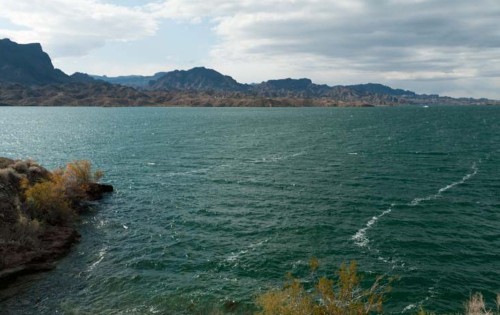
We all know that wind-blown banks can produce a TON of fish. However, fishing a windblown bank can be incredibly hard and possibly dangerous if you don’t have the right equipment.
That’s why some anglers will put use a drift sock on one of the corners of the stern of the boat. If you notice that the wind is still too strong attach a second Drift Master Drift Sock.
Depending on the wind, start with the 33-inch size, then if you notice the wind is still too strong, then use two drift socks.
Keeping your drift sock located on the rear corner of the boat so it allows your electronics to perform optimally by staying out of the way!
Rivers & Current

Drift socks also work amazingly when fishing in a river or a current.
In addition, there are a few ways to use a drift sock in a river or in a tidal current.
You can “pin” your position. This involves anchoring upstream and using the drift sock to lock in your location.
You can also use a drift sock to slow down your drift to fish a spot that you would normally cruise by.
Want to be the best fisherman? I wrote an in-depth report that shows you a weird trick to use a drift sock in current… in less time than it would take to drink a cup of coffee.
What Is The Best Drift Sock?
It’s a difficult question to answer because of the variables that need to be considered. The most important factors you must consider are: what type of vessel do you own? A boat, pontoon, kayak, or canoe? What length and size is the craft you’re fishing from?
Unfortunately, I do not have enough room to discuss that in this post…
But you’re in luck! I wrote two separate reports that cover that exact topic.
If you fish from a kayak, canoe, or paddleboard and want a drift sock, I wrote a complete report on all the best drift socks for these products.
Read more: Best Drift Sock For Kayaks or Canoes (Our Top Picks)
Likewise, if you fish from a boat, then you must read my detailed report of all the best drift sock for any size boat you own.
Read more: Best Drift Sock For Any Size Boat (Our Top Picks)
Drift Sock Sizing
Drift Socks are available in a variety of sizes.
When you’re faced with different options you need to know what size drift anchor you need to deploy that is why we made this basic sizing chart:
| Boat Size | Light – Moderate Wind or Current | Strong Wind or Current |
|---|---|---|
| 14 feet or less (small jon or v-hull boats, canoes, kayaks, SUP | 33-inch drift sock | 33-inch drift sock |
| 15 – 21 feet (standard fishing boat or small pontoon boats) | 33-inch drift sock | 50+ inch drift sock |
| 22+ feet (large fishing boats or pontoon boats) | One 50+ inch sock, or two 33-inch drift socks | Two 50+ inch drift socks |
But it doesn’t stop there…
If you’re a boat owner and you want to be given the perfect size drift sock for your make and model boat, well you’re in luck. Click here, where you can find your boat and be given the perfect drift sock size recommendation.
Read more: Drift Sock Size Chart For Boats
If you already have a kayak and you want to find the exact drift sock size that best fits your kayak then you need to click here.
Read more: Drift Sock Size Chart For Kayaks
DIY “Drift Sock” - How to use a 5 gallon bucket for a “drift sock”
If you don’t want to buy a premium drift sock and think it’s the best idea to build your own, then check out this youtube video.
Homemade drift sock bucket
Therefore, before you even think of making your drift sock for trolling, you have to understand how they are made up and what qualities they should carry. You have to ensure that the blank rod is solid and powerful enough to set the hook, yet sensitive enough to detect even the smallest bites.
Choosing the right drop shot rod can be a little stressful. You want to get the best rod your money can buy. That’s why I wrote a complete hands-on review of the best drop shot rods for any budget. I discussed all the great features and even I outlined the durability issues I found. Click HERE to read more.
Other Drift Fishing Related Articles
- Drift Sock Basics – What It Is & How To Use It [2021 Quick Start Guide]
- How To Use A Drift Sock In Rivers & Current [Our Top 10 Tips]
- Complete Drift Sock Size Chart For Your Boat
- Drift Sock Size Chart For Your Kayak
- Best Drift Socks For Boats [2021 Buyer's Guide - Reviewed/ Tested Results]
- Buyer's Guide - Best Drift Socks For Kayaks 2021
Accessories You’ll Need
Fishing Rod
 Rod –The popularity of fishing is growing and people are becoming much more conscious of different rods that can help them.
Rod –The popularity of fishing is growing and people are becoming much more conscious of different rods that can help them.
Fishermen want the best technique-specific rod for the money.
Luckily, the report I wrote provides you with detailed information in order for you to make buy the rod for the money, and more importantly which rods to avoid at all costs.
>> What Rods To Use For Bass Fishing? 10 Awesome General Purpose Rods Reviewed
Fishing Reel
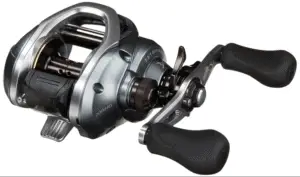
Reel – Having the correct reel to match with your rod is just as important. A good reel should be light and have a buttery smooth drag. There are several great reels on the market, but I recommend the a quality Shimano baitcasting reel. It’s a great reel packed with great features. So much so that it could easily be priced in the mid $200 range.
>>How To Choose A Great Bass Fishing Reel For The Money [and which to avoid at all costs]
Fishing Line
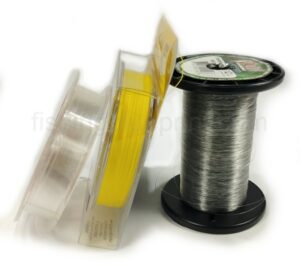
Fishing Line – Having a good line is just as important as having a good rod. I recommend fishing with a good fluorocarbon line. Furthermore, it’s super sensitive because it has little to no stretch, and underwater it’s invisible to the bass! If pride or money is on the line I would use Sunline Sniper FC.
>>21 Tips To Choose The Best Fishing Line
Fishing Lures & Baits

Fishing Lures – It’s pretty hard and darn near impossible trying to catch a fish without using some sort of lure or bait. More importantly these baits you should never forget at home or it could lead to a horrible day on the water
>>5 Bass Fishing Lures You Never Want to Leave At Home
Fish Finder
Finding lunker bass has never been easier when using a fish finding sonar unit. Packed with additional features to make your day on the water even easier. Maps that can plan your day or help you find your way back even in the darkest of nights. Bright bold numbers and letters to make reading the maps easy even in the brightest of days, and colors that pop and make it quick and easy to identify fish.
If you have a boat, kayak, canoe, or float tube, you need a fish finder.
Here’s our choice for the best fish finder between $299-$800:
Humminbird HELIX 7 CHIRP MEGA SI
It has all the features for any serious fisherman whether you’re an avid weekend warrior, or a tournament angler. This has all the bells and whistles you’re looking for.
>> Click HERE to Read The Reviews About Humminbird HELIX 7 CHIRP MEGA SI now
Here’s our choice for the best economic fish finder:
Garmin Stryker
While others look for bites, your fishfinder and GPS plotter help you reach your daily limit. You can mark preferred docks, ramps, and hotspots to easily return to them later and even share waypoints.
Click HERE to Read The Reviews About Garmin Stryker now!
Life Vest
According to Statista, “In the United States, 658 people died as a result of boating accidents and 2,641 people were injured in 2021.”
And it gets even worse… The National Safe Boating Council reported, “Where cause of death was known, 81% of fatal boating accident victims drowned.”
And if that’s not enough the incidence of deaths has climbed dramatically in recent years.
So if you’re on the water you NEED to wear your life vest. Protect you, your friends, and your families lives by wearing a life vest every time you’re on the water.
I recommend the ONYX PFD. It’s comfortable for all day use and there is lots of room for the air to move around so you won’t get sweaty.
>>Click HERE to read all the reviews actual customers!
Sunglasses
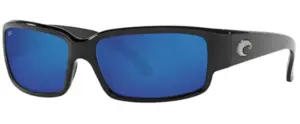 Sunglasses – Do you find yourself fishing in variable light and water conditions? Fishing in open water? Fishing in the bright hot sun? Then, only to leave the lake with eye strain and a splitting headache?
Sunglasses – Do you find yourself fishing in variable light and water conditions? Fishing in open water? Fishing in the bright hot sun? Then, only to leave the lake with eye strain and a splitting headache?
If so, I strongly recommend investing in a pair of Costa Sun Glasses. Thousands of anglers, charter guides, and tournament professionals put their trust into Costa, and so should you. Here’s why…
Costa’s co-injected bio-based nylon frame material is robust and durable, as well as extremely comfortable to wear for all-day use. TR-90 nylon is an excellent material for sports and performance frames since it is heat and cold-resistant.
Costa builds their glasses with class-leading technology. Their 580G glass lens sets them apart from the competition. These lenses are ideal for long days on the lake or sea since you won’t have to worry about scratches on the lens when you wipe the saltwater off. Needless to say they’re Costa’s most durable lenses.
Anyone who spends time outside, especially on the lake, needs polarized lenses. However, not all polarized sunglasses are the same. Costa is 99.9% polarized, giving it the most effective possible in blocking reflecting glare, and minimizing eye strain and headaches.
>>Click HERE to Read The Reviews On These Costa Sunglasses Right Now!
Drift Sock
Simply speaking, a drift sock (also known as a drift anchor) is like a parachute for the water. It gives you the ability to silently troll without spooking the fish!
Anyone who fishes out of a boat, canoe, kayak, stand up paddle board, or any other type of floating vessel should have a drift sock ready to use.
In addition to helping you catch more fish, recreational boaters also like to have 1-2 drift socks handy, just in case their motor goes out on them the drift sock will help slow their drift. This could be instrumental to allow rescuers to find that boat quickly and easily.
I strongly recommend the Drift Master Drift Sock by Mythik Outdoors.
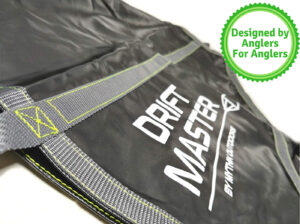 The construction is solid. Holding this in your hands gives you the peace of mind this feels durable and dependable.
The construction is solid. Holding this in your hands gives you the peace of mind this feels durable and dependable.
I love that it’s made from the gorilla-strong “RipStop” high density material, and I like that it’s even paired with the high-density nylon strapping.
It’s 30% stronger than other competitors who use a cheaper version of the RipStop material, so you never have to worry about his ripping.
Looking closely I can see they even triple stitched the high-tension points which is a good feature.
But best part… the Drift Master comes in a complete kit!
So get yours today and don’t leave yourself adrift.
The last thing to note is the Mythik Outdoors Drift Master drift sock kits sell out fast, so make sure you get yours before they’re gone!
>>Click HERE to Read The Reviews On This Drift Sock Today!
Landing Net
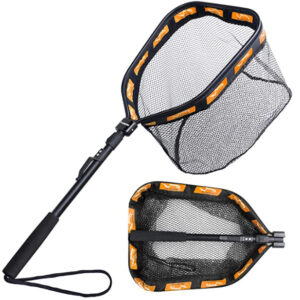 Landing Net – As you are reeling in that monster fish, you don’t want to injure yourself or knock the fish off the hook by trying to grab it.
Landing Net – As you are reeling in that monster fish, you don’t want to injure yourself or knock the fish off the hook by trying to grab it.
The PLUSINNO floating landing net is designed with foam padding on the hoop and provides buoyancy for fishermen. Now, If the net is dropped or blown overboard, the floating design makes it simple to retrieve – so you won’t have to be concerned about losing it! The rubberized net cannot be snagged. It keeps the fish safe for catch-and-release, and the non-absorbent covering avoids waterlogging and odor absorption in the net. It’s collapsing design allows for easy storage.
That’s why I recommend a dependable telescopic landing net.
>>Click HERE to Read The Reviews On This Floating Landing Net Today!
Fishing Weight Scale & Culler
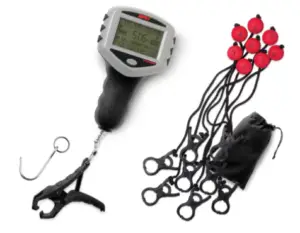 Fishing Weight Scale – Whether you’re going to keep your catch or just take a photo of it and brag to your friends it’s important to have an accurate scale. The Rapala Tournament Model Touch Screen Scale makes weighing and logging your catch easier and more convenient. The large digital scale has a lot of functions and is easy to use. simply keep track of your current catch and its place in your overall weight. To see the weight, just suspend the catch from the heavy-duty composite clamp or the accompanying stainless steel hook. Adding the important details to your catch couldn’t be easier – simply input your catch’s weight and tap on one of the eight storage places. The culling process makes it simple to identify fish that should be released for the greatest overall weight.
Fishing Weight Scale – Whether you’re going to keep your catch or just take a photo of it and brag to your friends it’s important to have an accurate scale. The Rapala Tournament Model Touch Screen Scale makes weighing and logging your catch easier and more convenient. The large digital scale has a lot of functions and is easy to use. simply keep track of your current catch and its place in your overall weight. To see the weight, just suspend the catch from the heavy-duty composite clamp or the accompanying stainless steel hook. Adding the important details to your catch couldn’t be easier – simply input your catch’s weight and tap on one of the eight storage places. The culling process makes it simple to identify fish that should be released for the greatest overall weight.
I recommend a Rapala Tournament Scale that has a large LED display like this one fishing scale here.
>>Click HERE to Read The Reviews on This Tournament-Grade Fishing Scale & Culling System now!
FAQ
What happens if your drift sock gets stuck or snagged?
Unfortunately, it’s inevitable your drift sock will get snagged on submerged structure. If that happens you can backtrack just slightly behind where the sock is snagged. Simply pull the collapsing cord first. Many times your drift comes right off the snag.
What happens if your drift sock gets ripped?
Rips tend to occur with the cheaper drift socks and drift bags since that is not made with the ultra-durable Rip-Stop material.
If you do rip it you can try to sew it up yourself. Getting your sock snagged and torn is not considered a product defect and it is unlikely the manufacturer will replace it. But you could always try.
Do drift socks sink?
Without any float devices such as buoys, yes your drift sock will sink.
What happens if the wind or current dies down?
If the wind our current dies down it’s important to pack up your drift sock. It’s really nice to be able to store it in a water-resistant bag. We recommend using this one here, and best of all you can buy it from Amazon.
Can I use a drift sock for saltwater fishing?
Absolutely! Using a drift sock in any tidal or current setting will work great.
How do I store my drift sock when I’m not using it?
Storing your drift sock, harness line, and collapsing strap are easy if it comes with a storage bag. Otherwise, all the lines and straps can get tangled, turning a fun day of fishing into a frustrating day. I full-heartedly recommend the Drift Master brand drift sock kit because it already comes with a heavy-duty water-resistant storage bag making store-and-stow quick and easy. Click here to check availability on Amazon.
I want to stop my kayak while I’m diving. Will a drift sock help with that?
No, a drift sock will only slow you down. Buying an anchor will help you completely stop your drift. If you need an anchor for your kayak, we recommend this one here.
Wrapping It Up
We hope that we didn’t overwhelm you by giving you too much information. All we care about is providing you with the best content to help you on the water. Hands down!
Source (1)
George Servinson
My name is George and I'm been fishing my entire life and love all things outdoors. My passion is helping anyone catch more fish. The newest things I've been doing lately is learning how to break down and clean all my reels, teaching my boy how to kayak fish, and bushcraft wilderness survival.

